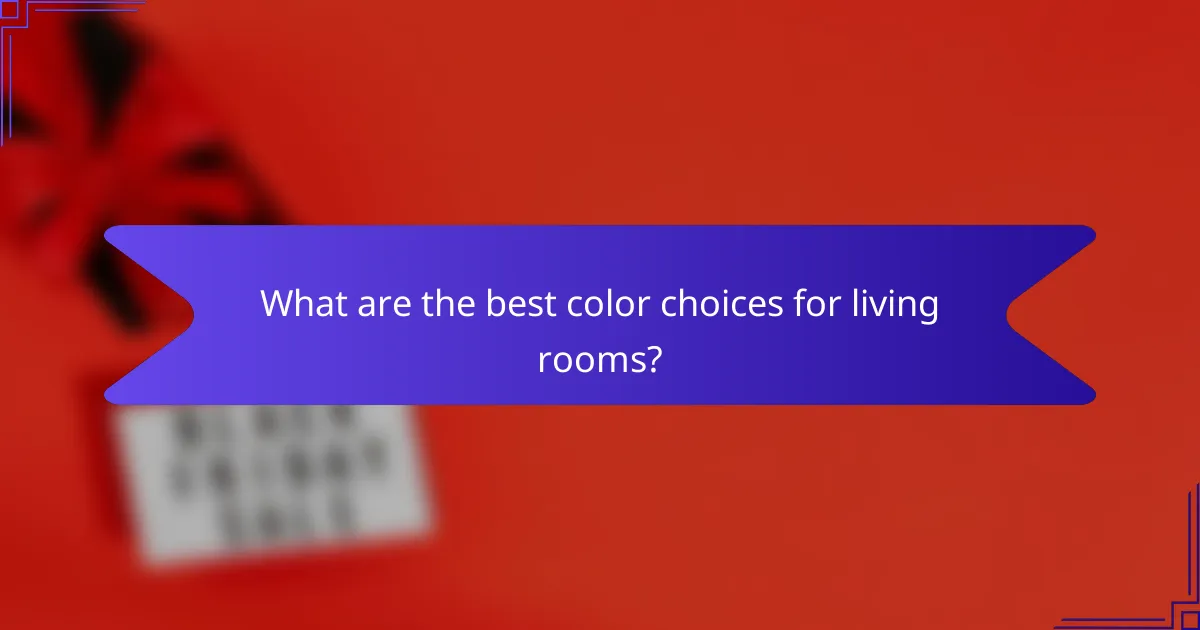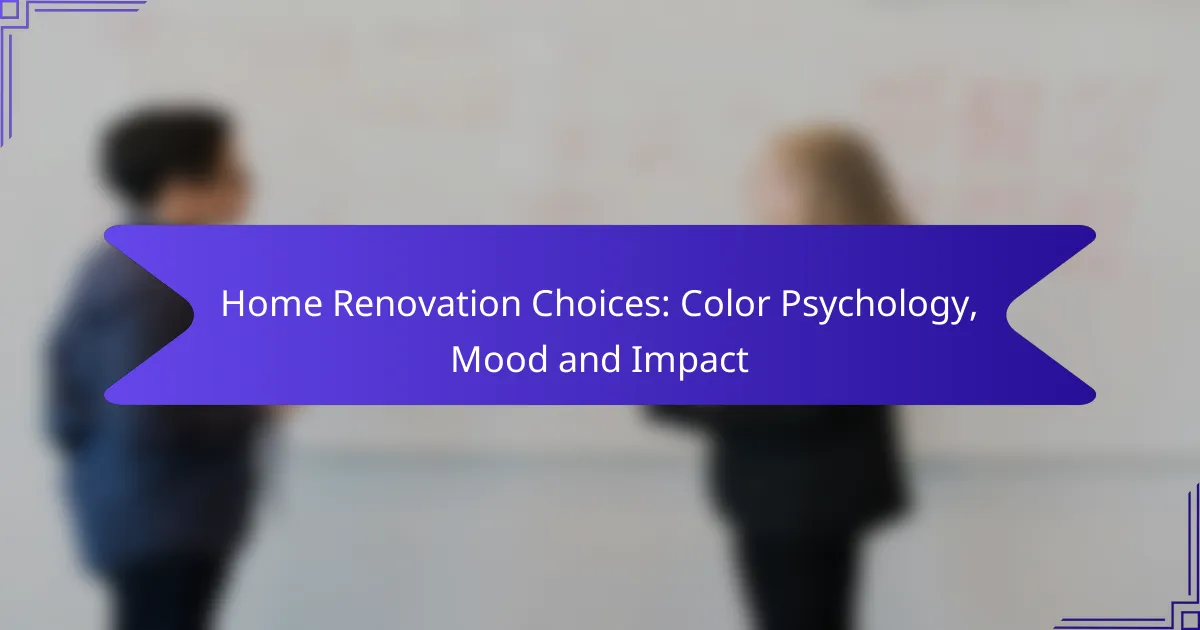Color psychology plays a crucial role in home renovation choices, as it directly influences mood and perception. By selecting the right colors, homeowners can create inviting atmospheres, enhance the functionality of spaces, and elevate the overall aesthetic appeal of their homes.

How does color psychology influence home renovation in South Africa?
Color psychology significantly impacts home renovation choices in South Africa by affecting mood and perception. Selecting the right colors can create desired atmospheres, enhance space functionality, and influence the overall aesthetic appeal of a home.
Warm colors create inviting spaces
Warm colors, such as reds, oranges, and yellows, evoke feelings of warmth and comfort. These hues are ideal for social areas like living rooms and dining spaces, where interaction and connection are encouraged.
When using warm colors, consider the intensity and saturation. Bright shades can energize a room, while softer tones can create a cozy ambiance. For example, a muted terracotta can be inviting without overwhelming the senses.
Cool colors promote calmness
Cool colors, including blues, greens, and purples, are known for their calming effects. These shades are perfect for bedrooms and bathrooms, where relaxation and tranquility are essential.
In South Africa, light blues and soft greens can reflect the natural landscape, enhancing the feeling of serenity. When choosing cool colors, aim for lighter shades to maintain an airy atmosphere, especially in smaller spaces.
Neutral colors enhance versatility
Neutral colors like whites, grays, and beiges provide a versatile backdrop that complements various design styles. They allow homeowners to easily change decor and furnishings without clashing with the wall colors.
Using neutral tones can also make spaces appear larger and more open, which is beneficial in urban settings. Consider adding pops of color through accessories or artwork to maintain interest while keeping the overall look cohesive.

What are the best color choices for living rooms?
The best color choices for living rooms often include earth tones, soft blues, and bold accents. These colors can significantly influence the atmosphere, comfort, and overall mood of the space.
Earth tones for warmth
Earth tones, such as browns, tans, and muted greens, create a cozy and inviting environment. These colors mimic natural elements, making the living room feel grounded and connected to the outdoors.
When selecting earth tones, consider using a palette that combines various shades to add depth. For example, pairing a warm beige with olive green can enhance the warmth and create a harmonious look.
Soft blues for tranquility
Soft blues are ideal for promoting a sense of calm and relaxation in the living room. These shades evoke the serenity of the sky and water, making them perfect for spaces where you unwind.
To achieve a tranquil atmosphere, opt for lighter shades like powder blue or sky blue. These colors work well with white or light gray accents, creating a soothing and airy feel.
Bold accents for personality
Incorporating bold accent colors, such as deep reds, vibrant yellows, or rich purples, can inject personality into your living room. These colors can serve as focal points, drawing attention and sparking conversation.
When using bold colors, balance is key. Consider painting an accent wall or using colorful accessories like cushions and artwork to avoid overwhelming the space. This approach allows you to express individuality while maintaining a cohesive look.

How can color impact mood in home environments?
Color significantly influences mood in home environments by affecting emotions and perceptions. Different colors can evoke specific feelings, making it essential to choose hues that align with the desired atmosphere of each room.
Red increases energy
Red is a vibrant color that stimulates energy and excitement. It can enhance feelings of passion and urgency, making it suitable for spaces where activity and interaction are encouraged, such as living rooms or home gyms.
However, too much red can lead to feelings of aggression or anxiety. Use it as an accent color rather than the primary hue to maintain a balanced environment.
Green reduces stress
Green is often associated with nature and tranquility, making it an excellent choice for reducing stress. Incorporating green into spaces like bedrooms or home offices can promote relaxation and a sense of calm.
Consider using various shades of green, such as soft pastels for a soothing effect or deeper tones for a more grounded atmosphere. Plants can also enhance this calming effect, providing both color and a connection to nature.
Yellow boosts creativity
Yellow is a bright and cheerful color that can stimulate creativity and optimism. It is particularly effective in workspaces or creative areas, encouraging innovative thinking and a positive mindset.
To avoid overwhelming the senses, use yellow in moderation, such as on an accent wall or through decorative elements. Pairing it with neutral tones can help create a balanced and inspiring environment.

What are the top color trends for home renovations in 2023?
In 2023, popular color trends for home renovations include pastel shades, dark hues, and biophilic colors. These trends aim to create specific moods and enhance the overall aesthetic of living spaces.
Pastel shades for subtle elegance
Pastel shades are favored for their ability to create a calm and inviting atmosphere. Soft colors like mint green, blush pink, and light lavender can make spaces feel airy and spacious, making them ideal for smaller rooms.
When using pastels, consider pairing them with neutral tones to maintain balance. For instance, a pastel blue can be complemented with white or beige furniture to enhance the elegant feel without overwhelming the senses.
Dark hues for dramatic effect
Dark hues, such as navy blue, charcoal gray, and deep forest green, are trending for their bold, dramatic impact. These colors can add depth and sophistication to a room, making them suitable for accent walls or cozy spaces like home theaters.
However, it’s essential to use dark colors judiciously. They can make a room feel smaller, so ensure adequate lighting and consider using lighter decor elements to prevent a heavy atmosphere.
Biophilic colors for nature connection
Biophilic colors, inspired by nature, include earthy tones like terracotta, olive green, and sky blue. These colors promote a sense of well-being and connection to the outdoors, making them perfect for spaces designed for relaxation.
Incorporating biophilic colors can be as simple as painting a room in a soft green or adding natural materials like wood and stone. This approach not only enhances aesthetics but also contributes to a healthier indoor environment.

What factors should be considered when choosing colors?
When selecting colors for home renovation, consider the room’s purpose, lighting conditions, and your personal preferences. These factors significantly influence how colors affect mood and overall ambiance.
Room purpose and function
The intended use of a room plays a crucial role in color selection. For instance, calming colors like soft blues or greens are ideal for bedrooms, promoting relaxation and sleep. In contrast, vibrant colors such as yellows or oranges can energize spaces like kitchens or playrooms.
Consider the emotional response you want to elicit in each space. For example, a home office may benefit from stimulating colors that enhance focus, while a living room might call for warmer tones to create a welcoming atmosphere.
Lighting conditions
Natural and artificial lighting can dramatically alter how colors appear in a room. North-facing rooms typically receive cooler light, making warmer colors more appealing to create balance. Conversely, south-facing rooms bask in warm light, allowing cooler shades to shine without appearing dull.
Test paint samples under different lighting conditions before making a final decision. Observing how colors change throughout the day can help ensure they maintain the desired effect in various lighting situations.
Personal preferences and lifestyle
Your individual taste and lifestyle should guide your color choices. If you prefer a minimalist aesthetic, neutral tones may suit you best, while those who enjoy bold designs might opt for striking colors or patterns. Consider how often you change your decor and how easily you can adapt to new colors.
Additionally, think about the maintenance of your color choices. Lighter colors may show dirt more easily, while darker shades can fade over time. Choose colors that align with your lifestyle and the level of upkeep you are willing to commit to.

How do cultural influences affect color choices in South Africa?
Cultural influences play a significant role in shaping color choices in South Africa, as different communities associate various colors with specific meanings and emotions. Understanding these associations can help homeowners select colors that resonate with their cultural backgrounds and the intended atmosphere of their spaces.
Understanding cultural color meanings
In South Africa, colors often carry deep cultural significance. For instance, red may symbolize strength and resilience in some cultures, while in others, it might represent danger or warning. Knowing these meanings can guide homeowners in selecting colors that align with their values and the messages they wish to convey in their homes.
Additionally, colors can evoke feelings and memories tied to cultural heritage. For example, earthy tones may remind individuals of the natural landscapes of the country, fostering a sense of connection to the environment. This emotional resonance can enhance the overall ambiance of a home.
Regional variations in color preferences
Color preferences can vary significantly across different regions of South Africa. In urban areas, brighter, more modern colors may be favored, reflecting contemporary trends. In contrast, rural communities might lean towards traditional colors that reflect their cultural identity and history.
When renovating a home, it is beneficial to consider local trends and preferences. Engaging with local artisans or designers can provide insights into popular color schemes that resonate with the community, ensuring that the renovation feels authentic and culturally relevant.
Practical tips for choosing colors
When selecting colors for home renovation in South Africa, consider the cultural context and the emotional impact of colors. Start by researching the meanings associated with different colors within your community. This knowledge can help you avoid choices that may be misinterpreted or culturally insensitive.
It’s also wise to test color samples in your space before making a final decision. Observe how natural light interacts with the colors at different times of the day. This practical step can prevent costly mistakes and ensure that the chosen colors create the desired mood and atmosphere in your home.
